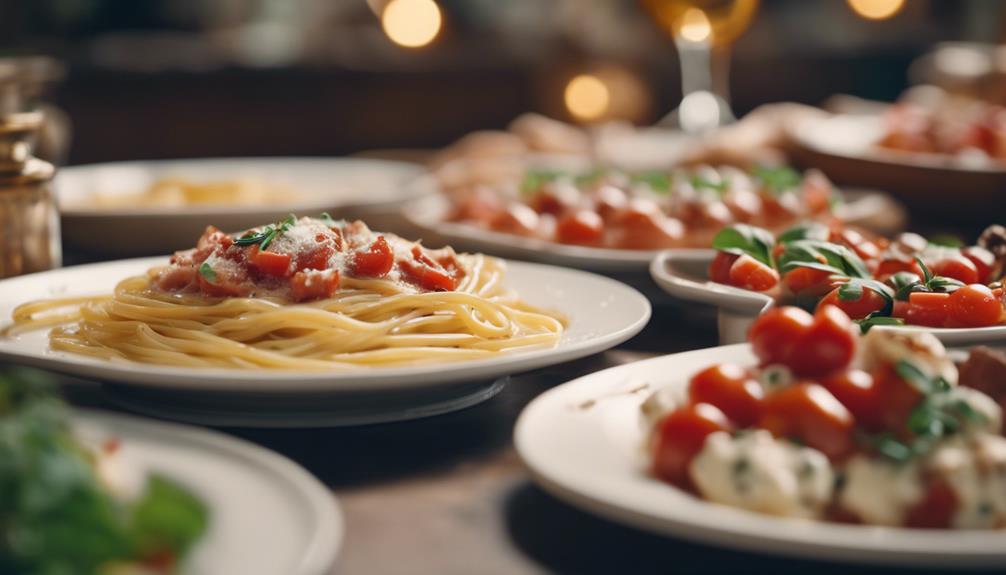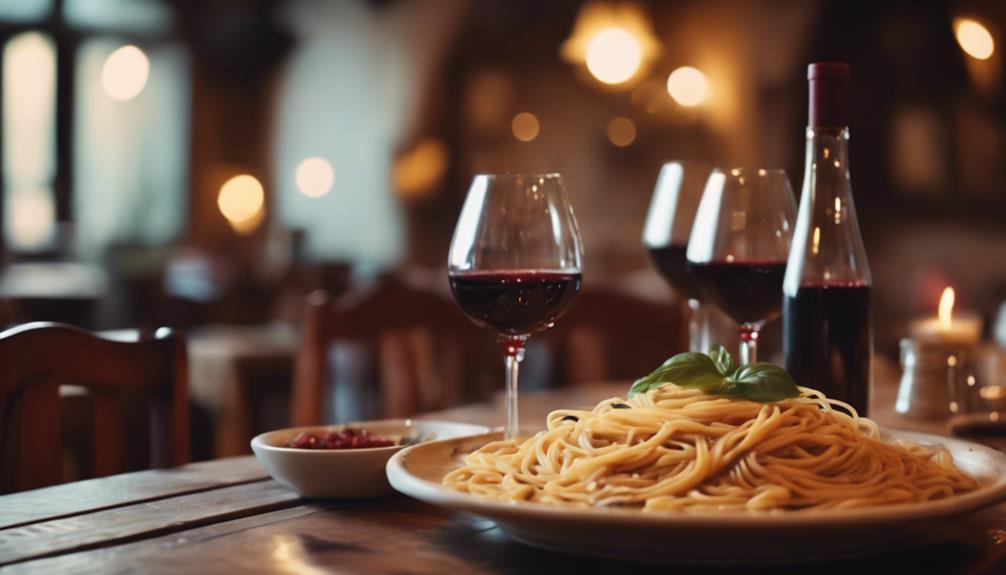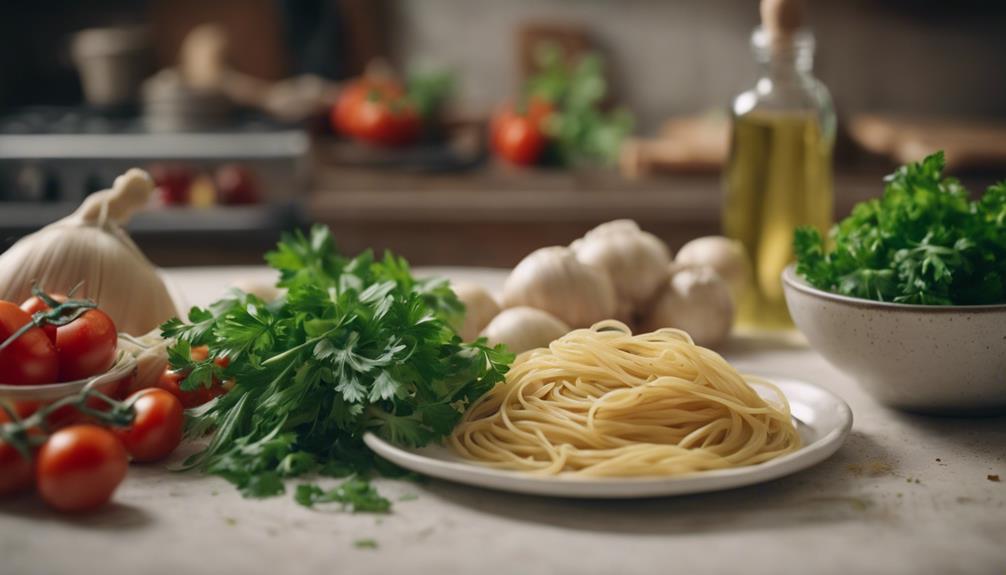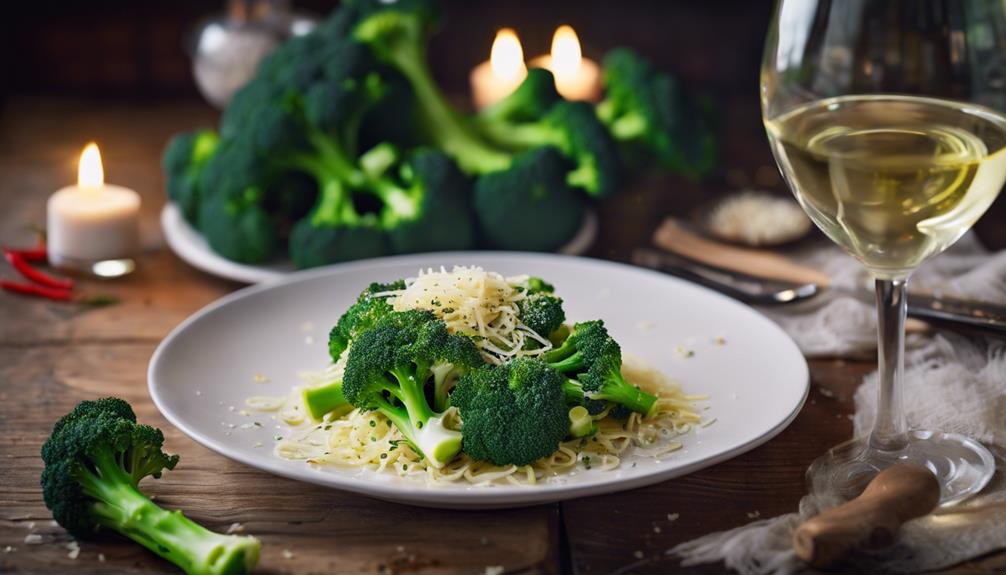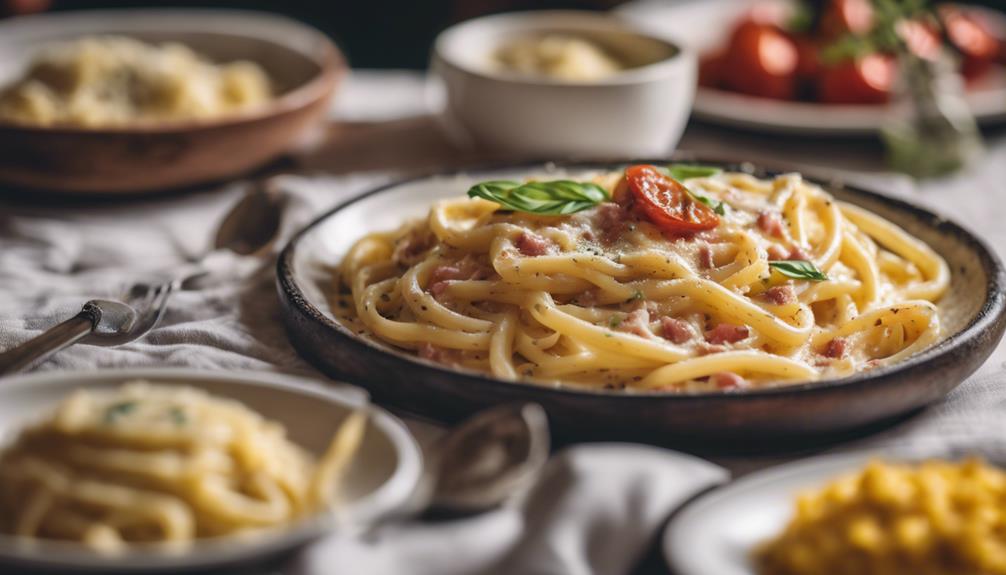In the realm of genuine Italian cuisine, authentic Italian dishes are a treat for your taste buds! Consider classic pasta dishes such as Bolognese, Carbonara, and Pesto, all of which highlight simplicity and high-quality ingredients. The Pizza Margherita, topped with tomato sauce, mozzarella, and basil, pays homage to Queen Margherita of Savoy by showcasing the colors of Italy’s flag. Seafood aficionados will be delighted by dishes like Brodetto di Pesce and herb-crusted Mediterranean Sea Bass. Indulge in decadent risotto recipes made with Arborio rice, known for its velvety texture and comforting taste. And don’t forget about delectable Italian desserts like creamy gelato and the iconic Tiramisu! Embark on a mouthwatering journey through the culinary marvels of Italy!
Key Takeaways
- Real Italian dishes focus on simplicity and quality ingredients.
- Authentic Italian dishes include Bolognese, Carbonara, Pesto, and Pizza Margherita.
- Italian cuisine celebrates regional flavors and traditional recipes.
- Fresh seafood, rich risotto, and indulgent desserts are staples in Italian cooking.
- Italian-American cuisine blends traditional Italian recipes with American influences.
Classic Italian Pasta Dishes
When exploring the world of Italian cuisine, classic pasta dishes stand out as iconic representations of regional flavors and culinary traditions. Italians take their pasta seriously, and each dish tells a unique story of tradition and taste.
From the rich and meaty Bolognese to the creamy and indulgent Carbonara, and the vibrant and herby Pesto, Italian pasta dishes offer a variety that suits every palate. The key to these classic dishes lies not only in the pasta itself, often made with durum wheat and sometimes eggs, but also in the sauces that accompany them. Whether it's a tomato-based sauce, a velvety cheese sauce, or a simple olive oil and garlic dressing, the flavors are designed to complement and enhance the pasta's texture.
Moreover, Italian pasta dishes are often generously topped with grated cheese, such as Parmigiano-Reggiano or Pecorino Romano, adding a savory and salty kick to every bite. These dishes are a celebration of simplicity and quality ingredients, showcasing the essence of Italian culinary mastery.
Authentic Italian Pizza Varieties

When it comes to authentic Italian pizza varieties, you're in for a treat!
Let's discuss the origins of Pizza Margherita, the traditional toppings that make each variety unique, and the diverse regional styles that you can explore.
Get ready to venture on a delicious journey through the world of real Italian pizza!
Pizza Margherita Origins
Pizza Margherita, a beloved classic in the world of pizza, has its origins in Naples, Italy in the 18th century. This iconic pizza features a simple yet delicious combination of tomato sauce, creamy mozzarella cheese, and fragrant basil leaves.
Legend has it that the pizza was created to honor Queen Margherita of Savoy, representing the colors of the Italian flag with its red tomatoes, white cheese, and green basil.
The Pizza Margherita has since become a symbol of Italian culinary tradition and is even recognized by UNESCO as an Intangible Cultural Heritage.
In Naples, where it all began, every pizzeria prides itself on its unique recipe for the traditional Pizza Margherita, ensuring that each bite is a taste of history and authenticity.
Traditional Toppings Explained
Traditional Italian pizza varieties showcase a range of authentic toppings that include Margherita with tomato sauce, mozzarella, and basil, Marinara with tomato sauce, oregano, and garlic, and Quattro Stagioni with artichokes, olives, ham, and mushrooms. When exploring the world of traditional Italian pizza, you'll encounter a delightful array of toppings that vary from region to region. Here are some classic toppings you might find:
- Prosciutto e Funghi: A delicious combination of prosciutto (cured ham) and mushrooms, providing a savory and earthy flavor profile.
- Capricciosa: This pizza is a feast for the senses, featuring ingredients like artichokes, ham, mushrooms, and olives, offering a burst of flavors in every bite.
- Pizza ai Quattro Formaggi: Cheese lovers rejoice with this pizza topped with a blend of four cheeses, such as mozzarella, gorgonzola, parmigiano, and fontina.
- Pizza al Tonno: A simple yet satisfying choice, this pizza is adorned with tuna, onions, and sometimes capers, showcasing the versatility of Italian cuisine.
These traditional toppings reflect the rich culinary heritage of various Italian regions, each contributing its unique touch to the world of pizza.
Regional Pizza Styles
Across the diverse regions of Italy, you can discover an array of authentic pizza styles that reflect the unique culinary traditions of each area. Italian pizza isn't just a dish; it's a representation of regional flavors and cultural significance.
From the classic Margherita with its simple yet flavorful combination of tomato sauce, mozzarella, and basil originating in Naples, to the Marinara with its zesty mix of tomato, garlic, oregano, and olive oil found in other parts of Italy, each pizza style tells a story of its heritage.
Italian pizza dough plays an essential role in defining these regional pizza styles, typically made with flour, water, yeast, salt, and sometimes eggs, resulting in a thin and crispy crust that complements the toppings perfectly. Additionally, the secret pizza sauce recipes of each pizzeria contribute to the distinctiveness of these pizzas, enhancing the regional flavors and specialties.
It's no wonder that the art of making pizza has been recognized by UNESCO as Intangible Cultural Heritage, underscoring its deep cultural significance in Italy.
Traditional Italian Seafood Specialties

Italian culinary culture boasts a rich array of delectable seafood specialties that showcase the freshest fish and shellfish. When exploring traditional Italian seafood dishes, you'll encounter a variety of mouthwatering options that are sure to tantalize your taste buds:
- Brodetto di Pesce: This flavorful Adriatic-style seafood stew is a beloved dish that combines a medley of seafood such as fish, shrimp, and shellfish in a rich broth infused with herbs and spices.
- Garlic-Sautéed Shrimp: A versatile classic, these succulent shrimp are cooked to perfection with garlic, olive oil, and a touch of red pepper flakes, making them an ideal appetizer or pasta topping.
- Herb-Crusted Mediterranean Sea Bass: Simple yet elegant, this dish features tender sea bass fillets coated in a flavorful herb crust that captures the essence of the Mediterranean region.
- Serving Tradition: Italian seafood dishes are often accompanied by grilled or toasted bread, perfect for soaking up the delicious juices and sauces that accompany the meal.
In traditional Italian seafood cuisine, the emphasis lies on the quality and freshness of the ingredients, reflecting the significance of seasonal and locally sourced produce in creating authentic flavors.
Rich Italian Risotto Recipes
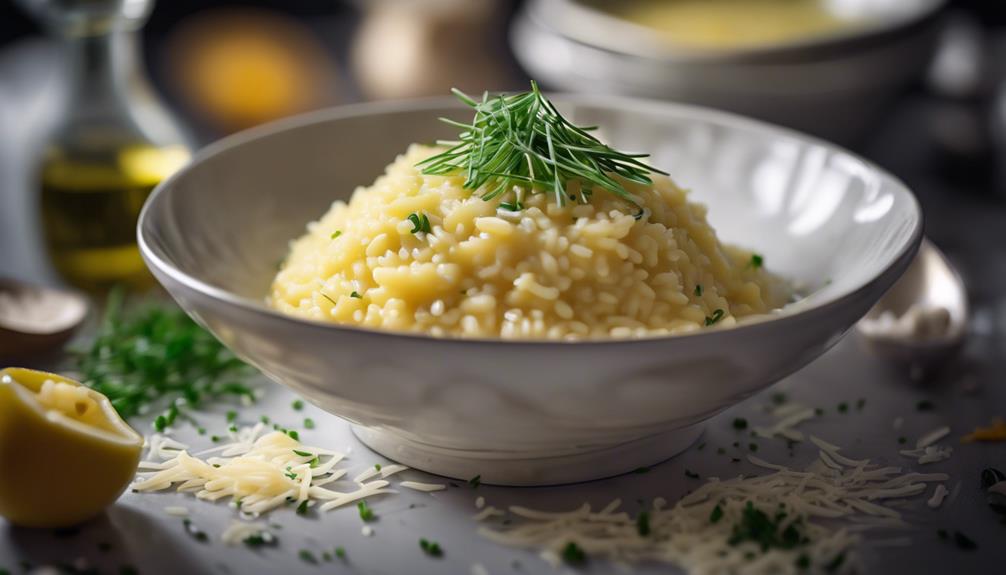
Indulge in the creamy decadence of rich Italian risotto recipes made with Arborio rice and an array of flavorful ingredients. In Italian cuisine, risotto shines as a beloved primo, offering a comforting and luxurious dining experience. The secret to its velvety texture lies in the slow cooking process and the constant stirring that releases the starch from the Arborio rice, creating a luscious creaminess that's simply irresistible.
When it comes to flavoring risotto, the options are endless. One popular variation is seafood risotto, where the delicate taste of the seafood perfectly complements the rich and creamy rice. Imagine savoring each spoonful of risotto flavored with succulent shrimp, tender calamari, or sweet scallops. The marriage of the briny goodness of the sea with the smooth Arborio rice is a match made in culinary heaven.
Whether you opt for a classic Risotto ai Frutti di Mare or get adventurous with a Risotto alla Pescatora, these seafood-infused risotto dishes are sure to transport your taste buds to the sun-kissed shores of Italy.
Delicious Italian Desserts to Try

Ready to satisfy your sweet tooth with some authentic Italian treats?
From the classic Tiramisu with its luscious layers of coffee-soaked goodness, to the rich flavors of traditional Italian sweets, there's a dessert for every palate.
Don't forget to cool off with some creamy gelato, boasting flavors like pistachio and hazelnut that will transport you straight to the streets of Italy.
Traditional Italian Sweets
Discover a delectable array of traditional Italian sweets that will tantalize your taste buds and transport you to the vibrant flavors of Italy. When it comes to iconic desserts, Italy boasts a rich heritage that includes treats like Tiramisu, the heavenly combination of espresso-soaked ladyfingers and creamy mascarpone cheese.
Cannoli, another favorite, features crispy pastry tubes filled with sweet ricotta and sometimes sprinkled with pistachios. And who can resist Gelato, Italy's famous frozen dessert that comes in a myriad of flavors like pistachio, hazelnut, and fruity delights?
Moreover, Italian sweets often showcase ingredients like mascarpone cheese, ricotta, espresso, and cocoa. Regional specialties such as Sicilian Cassata, Neapolitan Sfogliatelle, and Florentine Schiacciata offer a taste of Italy's diverse culinary landscape.
Panna Cotta, Zeppole, and Amaretti further exemplify the country's mastery in balancing sweet, creamy, and fruity elements in their desserts. Make sure to indulge in these delightful treats on your journey through the world of Italian cuisine!
Popular Gelato Flavors
Italian gelato, a beloved frozen dessert, offers a delightful array of popular flavors that are a must-try for anyone seeking a taste of Italy's sweet culinary delights.
Pistachio gelato, a classic favorite, brings a nutty and creamy experience to your taste buds. The richness of the pistachio flavor combined with the smooth and creamy texture of gelato creates a heavenly treat that's hard to resist.
Stracciatella gelato, on the other hand, presents a traditional yet indulgent option. This creamy delight blends milk-based gelato with fine chocolate shavings, striking the perfect balance between sweetness and richness. The delicate dance of flavors in stracciatella gelato is sure to leave you craving more.
These two flavors are just a glimpse into the world of Italian gelato, where each scoop offers a taste of Italy's passion for creating decadent and satisfying desserts.
Classic Tiramisu Recipe
Indulge in the classic Tiramisu recipe, a beloved Italian dessert originating from the Veneto region. This delectable treat combines layers of coffee-soaked ladyfingers with creamy mascarpone cheese, creating a harmonious blend of flavors and textures.
To make the perfect Tiramisu, follow these steps:
- Prepare the Base: Soak Savoiardi biscuits in a mixture of coffee and Marsala wine to create a moist and flavorful foundation for your Tiramisu.
- Layer the Ingredients: Alternate between layers of the coffee-soaked biscuits and a mixture of mascarpone cheese, cream, eggs, and sugar, ensuring each layer is evenly distributed.
- Dust with Cocoa Powder: Sprinkle a generous amount of cocoa powder on top of the final layer to add a rich and decadent touch to your Tiramisu.
- Chill and Serve: Allow the dessert to chill in the refrigerator for a few hours to let the flavors meld together before serving this classic Italian dessert to impress your guests.
Regional Italian Culinary Delights
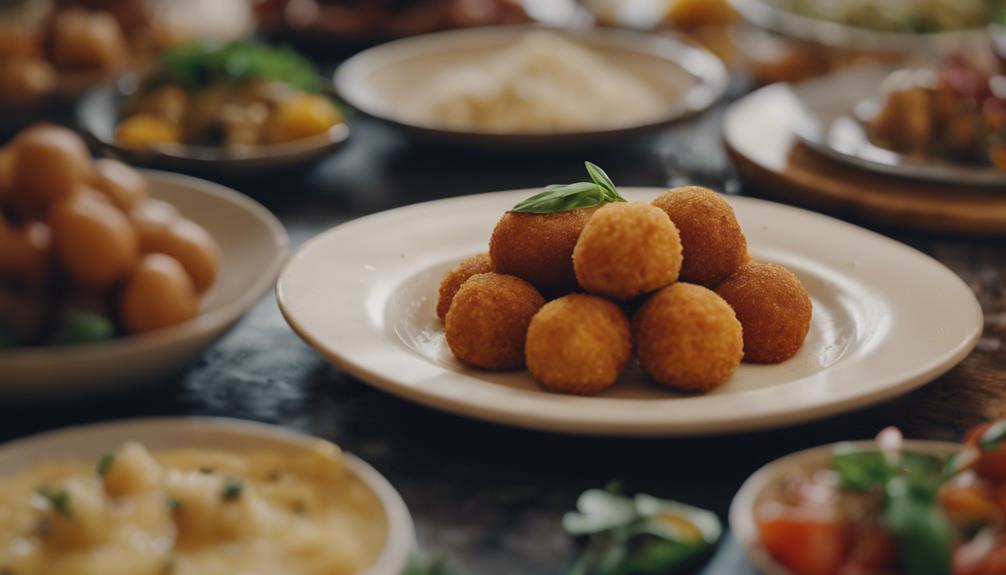
Explore the diverse culinary delights found in different regions of Italy, each offering unique and traditional dishes that showcase the country's rich gastronomic heritage. Italian cuisine is a treasure trove of regional specialties, from Bologna's hearty Bolognese and Milan's crispy veal Milanese to Sicily's delightful arancini.
Each part of Italy boasts its own culinary identity, with Tuscany's comforting ribollita soup, Rome's creamy cacio e pepe pasta, and Venice's flavorful risi e bisi rice and peas enchanting taste buds.
From the Mediterranean coast's fresh seafood dishes to Northern Italy's creamy risotto alla Milanese, the country's culinary diversity shines through its regional recipes.
Italian desserts are a sweet ending to any meal, with Sicily's iconic cannoli, Veneto's decadent tiramisu, and Piedmont's nutty hazelnut cookies delighting dessert enthusiasts.
Italian-American cuisine reflects the fusion of regional Italian traditions with American influences, resulting in favorites like New York-style pizza, baked ziti, and chicken Parmesan. These culinary delights from different regions of Italy offer a flavorful journey through the country's culinary landscape.
Frequently Asked Questions
What Are Authentic Italian Dishes?
When exploring authentic Italian dishes, you'll uncover a rich tapestry of flavors and textures. From classic Bolognese to delicate Caprese salad, each dish showcases the diversity and creativity of Italian culinary traditions.
What Is True Italian Cuisine?
In true Italian cuisine, flavors dance like a symphony, each ingredient harmonizing to create culinary magic. Freshness is key—olive oil, tomatoes, Parmesan cheese—an orchestra of tastes. Let simplicity shine, let seasons sing. Buon appetito!
Which Italian Dishes Are Actually American?
You should know that some Italian dishes like spaghetti and meatballs, chicken Parmesan, and baked ziti are actually American creations. Italian-American cuisine developed unique flavors by blending traditional recipes with local ingredients.
What Is the Official Dish of Italy?
When in Italy, pasta reigns as the official dish, embodying the essence of Italian cuisine. Its myriad shapes and sauces tell tales of culinary diversity. Explore spaghetti Bolognese, fettuccine Alfredo, and penne arrabbiata for a true taste of Italy.
Are Traditional Italian Dishes the Same as Real Italian Dishes?
When it comes to Italian cuisine, there can be a difference between traditional Italian dishes and what people may perceive as “real” Italian dishes. Traditional Italian dishes explained here often involve simple, fresh ingredients and regional variations, while “real” Italian dishes may include more modern interpretations and adaptations to suit various tastes.
Conclusion
So there you have it, a taste of Italy in all its delicious glory!
From classic pasta dishes to authentic pizza varieties and rich risotto recipes, Italian cuisine is a culinary journey worth taking.
So grab a fork, dig in, and let your taste buds travel to the sun-drenched streets of Italy with every bite.
Buon appetito!
